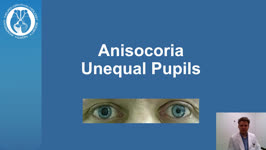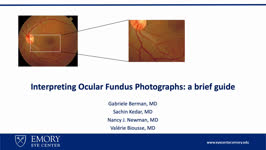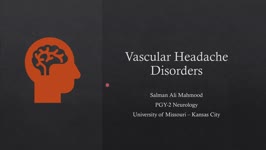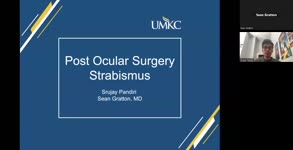Collection of materials relating to neuro-ophthalmology as part of the Neuro-Ophthalmology Virtual Education Library.
NOVEL: https://novel.utah.edu/
TO
- NOVEL233
| Title | Creator | Description | Subject | ||
|---|---|---|---|---|---|
| 26 |
 |
Glaucoma: Evaluation and Principles of Management | Anand Haran; Sean Gratton | This is a narrated powerpoint that reviews the basics of glaucoma. It covers Primary Open Angle Glaucoma and Angle Closure Glaucoma, and includes reviews of the pathophysiology, evaluation, and management | Angle Closure Glaucoma; Glaucoma; Primary Open Angle Glaucoma |
| 27 |
 |
Neuro-Ophthalmic Complications of Chemotherapy | Nagham Al-Zubidi; May Ameri | This lecture covers the effect of antineoplastic chemotherapy, which can cause damage to the optic nerve and the ocular motor nerves. | Antineoplastic Chemotherapy; Ocular Motor Nerve Damage; Optic Atrophy; Optic Nerve Damage; Optic Nerve Edema; Optic Neuritis |
| 28 |
 |
Patient Portal: Optic Disc Drusen | Cristiano Oliveira, MD | Optic disc drusen (ODD) are abnormal deposits of benign, usually calcified material within the optic disc, which is the front part of the optic nerve that connects each eye to the brain. We do not know the exact cause of optic disc drusen. They are present in 0.3-2% of people as an isolated case or ... | Optic disc drusen; Papilledema; Pseudopapilledema |
| 29 |
 |
Patient Portal: Microvascular Cranial Nerve Palsy | Meagan Seay, DO | A nerve palsy is an impairment in the function of a nerve, which results in a decrease in function of the corresponding muscles controlled by that nerve. In microvascular cranial nerve palsy, something affects the blood supply to one of the cranial nerves, causing it not to work. This is usually the... | Nerve palsy; Microvascular cranial nerve palsy; Cranial nerve 3; CN3; Oculomotor nerve; Cranial nerve 4; CN4; Trochlear nerve; Cranial nerve 6; CN6; Abducens nerve |
| 30 |
 |
Patient Portal: Non-Arteritic-Anterior Ischemic Optic Neuropathy (NAION) | Arun Sundaram, MD | Non-arteritic anterior ischemic optic neuropathy (NAION or NA-AION) is caused by decreased blood flow to the front part of the optic nerve (optic disc). It causes optic nerve swelling and sudden vision loss. NAION typically affects one eye, although the other eye sometimes suffers similar loss month... | Non-arteritic anterior ischemic optic neuropathy; NAION; NA-AION; Optic nerve; Optic disc; Ophthalmic artery |
| 31 |
 |
Patient Portal: Myasthenia Gravis | Aroucha Vickers, DO | Myasthenia gravis (MG) is an autoimmune disease in which the body's immune system creates antibodies (proteins that normally protect us) that may attack receptors on your muscles. This results in muscle weakness because the muscles do not receive the signals to contract (tighten). Muscles anywhere w... | Myasthenia gravis; Ptosis; Double vision |
| 32 |
 |
Patient Portal: Giant Cell Arteritis | Anne S. Abel, MD | Giant cell arteritis is an inflammatory condition that can cause vision loss, double vision, fever, new persistent headaches, scalp tenderness, and jaw pain with chewing. GCA is caused by inflammation of blood vessels, primarily in the head and neck. Sometimes called "temporal arteritis," GCA frequ... | Giant cell arteritis |
| 33 |
 |
Patient Portal: Idiopathic Intracranial Hypertension (IIH) | Devin D. Mackay, MD | Idiopathic intracranial hypertension (IIH), also called pseudotumor cerebri, is a condition in which there is high pressure in the fluid surrounding your brain, spinal cord and optic nerves. This can cause headaches and problems with vision. Although the cause(s) of the condition is not fully unders... | Idiopathic intracranial hypertension; Pseudotumor cerebri |
| 34 |
 |
Patient Portal: Homonymous Hemianopsia | James C. O'Brien, MD | Homonymous hemianopia refers to an absence of vision towards one side of the visual world in each eye. The damage that caused this problem is in the brain and not in the eyes. | Homonymous hemianopia; Visual pathway |
| 35 |
 |
Patient Portal: Optic Neuritis | Anthony Brune, DO | Optic neuritis is inflammation of the optic nerve. In optic neuritis, the covering around the fibers of the optic nerve (myelin) is damaged by inflammation (demyelination), which typically results in blurred or dark vision. | Optic neuritis; Myelin; Demyelination |
| 36 |
 |
Patient Portal: Transient Vision Loss | Anthony Brune, DO | Transient visual loss is the term used to describe loss of part or all of the vision in one or both eyes temporarily. Some people do not experience a complete loss of the affected vision and instead describe the abnormality as "blurring" or like "looking through a veil." The vision typically returns... | Transient visual loss |
| 37 |
 |
Patient Portal: Anisocoria | Nagham Al-Zubidi, MD | Anisocoria is a medical term for unequal pupil size. Normally our pupils are relatively the same size. While small differences in pupil size are normal and can even come and go (physiologic anisocoria), constant and significant differences in pupil sizes may be a sign of damage to the brain or the n... | Anisocoria; Horner Syndrome; 3rd Cranial Nerve Palsy; Adie Tonic Pupil |
| 38 |
 |
Patient Portal: Pituitary Adenoma | Nagham Al-Zubidi, MD | The pituitary gland is a pea-sized gland that sits underneath the base of the brain. It produces and releases many hormones. These hormones control your metabolism, stress level, growth, ovulation and menstruation in women, sperm and testosterone production in men, milk production, and urine product... | Pituitary Adenoma; Pituitary Tumor |
| 39 |
 |
Interpreting Ocular Fundus Photographs: A Brief Guide | Gabriele Berman; Sachin Kedar; Nancy J. Newman; Valerie Biousse | This is a brief guide to the interpretation of the ocular fundus photograph. In this presentation we will describe the structures that comprise the normal ocular fundus followed the abnormalities that can be detected on fundus photographs. By the end of the presentation, learners should be able to d... | Fundus Photograph; Glaucoma; Papilledema; Retinal Detachment |
| 40 |
 |
Retinal Venous Occlusive Disease | Ali Alkhabbaz; James Brian Davis; Amanda Dean Henderson | Retinal venous occlusion (RVO) includes central retinal vein occlusion (CRVO), hemi-central retinal vein occlusion (HCRVO), and branch retinal vein occlusion (BRVO). The most important risk factor for RVO is hypertension, but other risk systemic factors include advanced age and cardiovascular diseas... | Branch Retinal Vein; BRVO; Central Retinal Vein; CRVO; HCRVO; Retinal Venous Occlusion |
| 41 |
 |
Retinal Artery Occlusive Disease | Ali Alkhabbaz, MD; James Brian Davis; Amanda Dean Henderson, MD | Retinal arterial occlusion includes ophthalmic artery occlusion (OAO), central retinal artery occlusion (CRAO), branch retinal arteriolar occlusion (BRAO), from proximal to distal. These can occur with or without retinal ischemia and may be permanent or transient. There are 4 subtypes of CRAO: non-a... | Branch Retinal Arteriolar Occlusion; Central Retinal Artery Occlusion; Giant Cell Arteritis; Ophthalmic Artery Occlusion |
| 42 |
 |
Raymond Cestan Syndrome | Srujay Pandiri; Sean Gratton | This is a brief narrated powerpoint that explains the clinical presentation of Raymond Cestan Syndrome. This is a rare brainstem stroke syndrome that presents with ipsilateral internuclear ophthalmoplegia and contralateral hemiparesis as well as other features. It is sometimes referred to as upper d... | Brainstem Stroke Syndromes; Internuclear Ophthalmoplegia; Pons |
| 43 |
 |
Vergence Eye Movements | Yu Hsin Chen; Amanda Dean Henderson, MD | Vergence (e.g. convergence and divergence), a class of eye movements that rotates the eyes in opposite directions (disjunctive), serves to hold image on the fovea of both eyes in order to obtain a single, clear image. This presentation overviews the neurology and examinations of vergence response, w... | Convergence; Convergence Insufficiency; Convergence Spasm; Divergence; Divergence Insufficiency |
| 44 |
 |
Methanol Toxicity | Daniel Lovasz; James Brian Davis; Amanda Dean Henderson, MD | Methanol toxicity can be very dangerous with high morbidity and mortality rates, and outcomes typically worsen with increasing acidemia, hyperglycemia, or acute kidney injury. Delayed treatment can result in irreversible injury, such as vision loss, or even death. The harmful effects of methanol com... | Acidosis; Fomepizole; Formic Acid; Methanol Toxicity; Toxic Optic Neuropathy |
| 45 |
 |
Natural Language Processing in Neuro-Ophthalmology | Areeba Abid, BS; Sachin Kedar, MD | This video provides an overview of natural language processing (NLP) techniques, applications, and limitations in neuro-ophthalmology. NLP, a branch of artificial intelligence, enables computers to understand and analyze human language. This video discusses three types of NLP techniques: sentiment a... | Artificial Intelligence; Machine Learning; Natural Language Processing; Word Prediction; Word Embeddings; Sentiment Analysis |
| 46 |
 |
Therapeutics for Tuberous Sclerosis | Daniel Lovasz; Amanda Henderson, MD | Tuberous Sclerosis Complex (TSC) is a disease characterized by abnormal hamartomas and benign neoplasms in multiple organs. The diagnosis is made by the presence of 2 major features, or 1 major feature accompanied by 2 minor features. These features include various growths in different parts of the ... | Tuberous Sclerosis; Therapeutics; Everolimus; Sirolimus; Hamartomas; mTOR |
| 47 |
 |
Thiamine (Vitamin B1) Deficiency (Video) | Nirupama Devanathan; Devin D. Mackay, MD | 33-year-old female who initially presented with heat stroke that was thought to provoke cyclical vomiting over the course of 6 weeks, perpetuated by anxiety, resulting in a 15- pound weight loss. She presented to the ED with bilateral vision loss, bilateral lower extremity weakness and vertical nyst... | Thiamine; Upbeat Nystagmus; Nutritional Optic Neuropathy; Wernicke Encephalopathy |
| 48 |
 |
Treatment Outcomes of Ocular Manifestations in Wernicke's Encephalopathy: Video | Whitney Stuard Sambhariya, PhD, Medical Student; Melanie Truong-Le, DO, OD | The case of a 28- year-old woman with a past medical history of gastric sleeve who was reported to have blurry vision and presented to neuro-ophthalmology with double vision. On examination the patient had bilateral abducens palsy, alternating upbeat and downbeat nystagmus with a torsional component... | Wernicke's Encephalopathy; Ocular Manifestations; Neuro-ophthalmology; Sbducens Palsy; Nystagmus; Double Vision; Blurry Vision |
| 49 |
 |
Vascular Headache Disorders | Salman Ali Mahmood, MD; Sean Gratton, MD | This is a PowerPoint with embedded audio presenting a detailed summary of the evaluation and management of an important cause of secondary headaches: vascular headache disorders. Topics covered include intracranial hemorrhage, arterial dissection, giant cell arteritis, cerebral venous sinus thrombos... | Vascular Headache Disorders; Epidural Hematoma; Subdural Hematoma; Subarachnoid Hemorrhage; Intracranial Hemorrhage; Arterial Dissection; Giant Cell Arteritis; Cerebral Venous Sinus Thrombosis; Pituitary Apoplexy |
| 50 |
 |
A Brief Introduction to Post-Ocular Surgery Strabismus | Srujay Pandiri, Medical Student | This is a short narrated Powerpoint that introduces concepts important to post-ocular surgery strabismus. It highlights the connection between common surgeries include cataract surgery, scleral buckle surgery, refractive surgery, among others. | Diplopia; Strabismus; Post-ocular Surgery Strabismus |
